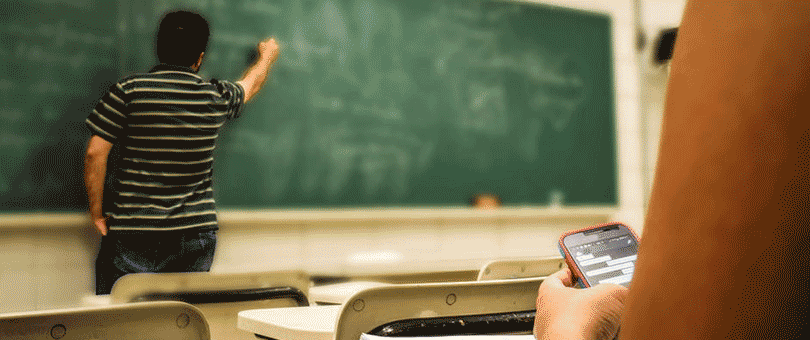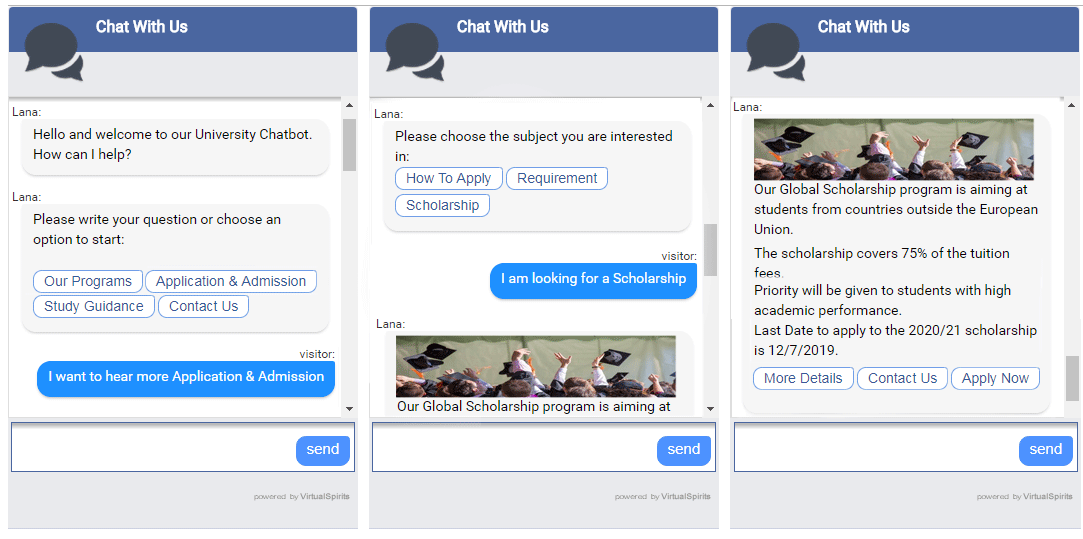
TOPICS:
Chatbot for University Building a chatbot
Higher Education Chatbot - How Can Chatbots Benefit Higher Education?
Thanks to higher education chatbots, Universities and colleges are supporting visitors and students, day in and day out, regardless of time zones or upticks in visitor traffic.
Ai isn’t a fad anymore. It has proved its merits in countless sectors, higher education among them. Chatbots are now a common sight on the websites of leading universities.
But that’s just the beginning. Higher education chatbots are rapidly becoming irreplaceable, because they bring real, measurable benefits to the colleges and universities that use them. Let’s look at some of these benefits.

Chatbot recruiting new students:
Students seek out a college or university because of the specific career path they have in mind. They aren’t exactly ‘buying’ a product that they’ll use for a few months or years. They’re making a life decision.
So when Liam, fresh out of high school and very interested in robotics, visits your college website, he has a bunch of questions. He doesn’t want to just read a sales pitch that’ll make him sign up. He wants answers to help him decide if a course at your college will be professionally and financially viable for him.
If your website uses an online chatbot, Liam’s task becomes much easier. Instead of reading the details of all the courses you offer, he can just ask your bot things like:
“What is the shortest robotics course you offer?”“What’s the difference between [Course A] and [Course B]?”“Does [Course A] include any internships?”Or even something like,
“Am I eligible for any of your scholarships?”Liam’s search thus gets significantly easier and quicker. Which is what he wants, as a multi-tasking, hyper-connected member of Gen Z. The user experience on your website encourages him to shortlist your university, increasing his chances of applying and enrolling.
Bots ensuring constant communication:
A term known as ‘summer melt’ has recently been doing the rounds of the university admissions scene. It refers to the phenomenon wherein students who’ve been accepted for a course at a university, fail to show up for enrollment after the summer break.
Let’s continue Liam’s example. He likes your robotics course and has applied for a place, but he’s also being safe and considering other options. He finds a couple of colleges that don’t quite offer a course he likes as much as yours. But one of them has a cheaper program, and the other has a campus in his city.
So how do you keep Liam interested in enrolling with you? With communication. Every time Liam visits your website after sending in his application, your AI bot can greet him with a friendly
“hello”. It can also invite him to check his application status right there through the chat window.
“I’ll update you on your application status in just a second,” your online chatbot tells Liam. “Please enter your application ID, or the email ID you’re registered with.”Liam types it in.
“Hey Liam, thanks for the info. Your application ID [X] is currently in Screening, Stage 2, and will be finalized in 3-5 business days. We’ll keep you posted via email.”Or it could go:
“Hey Liam, thanks for the info. Your application is under review. We’re waiting for your recommendation letters. If you’re ready with them, drop the files here to attach them to your application.”Even after Liam’s application is accepted, your higher education chatbot can send him helpful reminders about enrollment and fee payment, or invite him to ask questions about campus life, such as:
“Are pets allowed in the dorm rooms?”Or,
“How long will the freshmen’s orientation take?”And so on. Regular communication keeps students interested in enrolling with you, and keeps them reassured that their questions will be answered 24/7, without the need to contact the student support desk or stand in line for ages.
Creating a universally accessible college website:
Liam’s example shows how much easier it is to get information through one-on-one conversations, rather than reading pages of text or sending out emails. But there’s more. The presence of a higher education chatbot also makes your website more accessible to prospective students with disabilities.
For the visually impaired, a single point of contact (your live chat window) that dispenses all the information they need, is much easier to work with than an entire website with multiple directories and choices. Visually impaired students can also use their regular methods of giving voice commands instead of typing, to extract information from your website or check their application status. As such, using online chatbots helps you attract and engage a much broader spectrum of applicants.